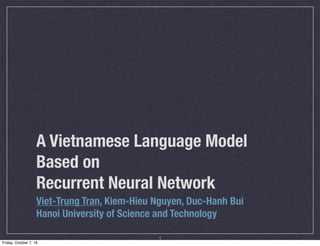A Vietnamese Language Model Based on Recurrent Neural Network
Language modeling plays a critical role in many natural language processing (NLP) tasks such as text prediction, machine translation and speech recognition. Traditional statistical language models (e.g. n-gram models) can only offer words that have been seen before and can not capture long word context. Neural language model provides a promising solution to surpass this shortcoming of statistical language model. This paper investigates Recurrent Neural Networks (RNNs) language model for Vietnamese, at character and syllable-levels. Experiments were conducted on a large dataset of 24M syllables, constructed from 1,500 movie subtitles. The experimental results show that our RNN-based language models yield reasonable performance on the movie subtitle dataset. Concretely, our models outperform n-gram language models in term of perplexity score.

Recommended
Recommended
More Related Content
What's hot
What's hot (20)
More from Viet-Trung TRAN
More from Viet-Trung TRAN (20)
Recently uploaded
Recently uploaded (20)
A Vietnamese Language Model Based on Recurrent Neural Network
- 1. A Vietnamese Language Model Based on Recurrent Neural Network Viet-Trung Tran, Kiem-Hieu Nguyen, Duc-Hanh Bui Hanoi University of Science and Technology 1Friday, October 7, 16
- 2. Outline Statistical language model Current state of the art RNN for Vietnamese language model Experimental results Conclusion 2 Friday, October 7, 16
- 3. Statistical language model A probability distribution of word sequence E.g. “go to the airport” ? = P(“airport”|“go to the”) Applications: Spelling checkers, smart keyboards Enhance speed recognition/machine translation LABAN KEY 3 Friday, October 7, 16
- 4. Challenges Meaningful grammatically correct understandable Context-aware E.g. I am from Vietnam. My mother-tongue is Vietnamese Out of vocabulary Slang, abbreviations, etc. 4 Friday, October 7, 16
- 5. Common approach N-gram language model Katz's back-off: estimates the conditional probability of a word given its history in the n-gram When trigram unavailable -> back-off to bi-gram -> uni-gram SOURCE: HTTPS://EN.WIKIPEDIA.ORG/WIKI/KATZ%27S_BACK-OFF_MODEL 5 Friday, October 7, 16
- 6. N-gram language model Only see a few words back Only predict words seen in the same context 6 Friday, October 7, 16
- 7. Deep learning for NLP Word embedding (SOCHER ET AL. (2013A)) MIKOLOV ET AL. (2013B). 7 Friday, October 7, 16
- 8. Recurrent neural network for text 8 INPUT : GO TO THE OUTPUT : TO THE SCHOOL PROBABILITY (SCHOOL | GO TO THE) Friday, October 7, 16
- 9. RNN vs. N-gram Foldable word context vs. fix n-gam context Personalization through continuous learning More meaningful text suggestions Naturally support phrase, terms suggestions 9 Friday, October 7, 16
- 10. RNN for Vietnamese language model Character level language model {previous characters} -> next characters Syllable level language model {previous syllables} -> next syllables 10 Friday, October 7, 16
- 11. LSTM cell SOURCE: HTTP://COLAH.GITHUB.IO/POSTS/2015-08- UNDERSTANDING-LSTMS/ 11 Friday, October 7, 16
- 12. Stacking multiple layers 12 Friday, October 7, 16
- 13. Experiments 1,500 MOVIES - 2.056.308 SENTENCES 13 Friday, October 7, 16
- 14. Experimental results 14 Friday, October 7, 16
- 15. 15 Friday, October 7, 16
- 16. Conclusion First neural language model for Vietnamese Largest experimental dataset Future work Word embedding Neural net compression Conversational neural machine translation 16 Friday, October 7, 16
- 17. Thank you for your attention 17 Friday, October 7, 16
- 18. Conversational Chú hoài linh đẹp trai. Chú hoài linh Chào buổi sáng chị hát hay wa!! nghe thick a. chị khởi my ơi e rất la hâm mộ chú hoài linh thật đẹp zai và chú Trấn thành đẹp qá 18 Friday, October 7, 16
- 19. lịch sử ghi nhớ năm 1979 tại hội nghị, đồng chí Phạm Ngọc Thủy Võ Văn Kiệt tại hội nghị, đồng chí Hồ Chí Minh nói tại hội nghị, đồng chí Võ Nguyên Giáp và đồng chí Hồ Chí Minh đã ngồi ở tại đại hội Đảng lần thứ nhất vào năm 1945, Ngay từ những ngày đầu, Đúng như nhận xét của Giáo sư Nguyễn Văn Linh 19 Friday, October 7, 16
